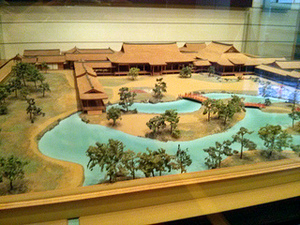Difference between revisions of "Shinden-zukuri"
| Line 1: | Line 1: | ||
| + | [[Image:Shinden.jpg|right|thumb|300px|A model of the [[Sanjo Palace|Higashi-Sanjô Palace]], an example of ''shinden-zukuri''.]] | ||
*''Japanese'': 寝殿造 ''(shinden-zukuri)'' | *''Japanese'': 寝殿造 ''(shinden-zukuri)'' | ||
Revision as of 12:30, 20 March 2012

- Japanese: 寝殿造 (shinden-zukuri)
Shinden-zukuri was a prominent architectural style used in Heian period aristocratic mansions. The Byodoin in Uji is the most famous surviving example of the style.
The central building, or shinden (lit. "sleeping palace") was connected to a number of other structures including two wings which extend out perpendicular to it, encircling a pond and garden. The wings consisted entirely of covered walkways, from which the garden could be appreciated, and did not contain any real residential spaces such as bedrooms, kitchens, or studies.
Other structures outside the shinden would have housed servants, kitchens, studies, tea rooms, various kinds of reception rooms or meeting rooms. Developing upon earlier modes and serving as the model for future styles down to the present, very few of the spaces in the complex were truly enclosed or dedicated to a single purpose. Only the main bedroom had any real walls, while everything else in the complex was enclosed only by shôji or fusuma, which could be slid open or removed entirely to alter the shape and size of a space for whatever purposes necessary, and to essentially open up the spaces to the exterior, to the elements, making any space in the complex (particularly the wings) essentially a semi-outdoor patio or porch.
Other prominent structures in the shinden-zukuri style include Itsukushima Shrine, the Sanjô Palace and the Hôjô-ji.